
Anderson Downtown Historic District is a national historic district located at Anderson, Madison County, Indiana. The district dates from c. 1887-1955 and encompasses 32 contributing buildings in the central business district of Anderson. Despite some loss of integrity due to demolition and alteration, the district still includes a significant collection of historic and architecturally distinguished commercial buildings. Aside from the usual historic commercial impact of similar districts, this district includes several properties that illustrate Anderson's transportation heritage. Included in the district or nearby are the following individual sites on the National Register of Historic Places: Paramount Theatre, Tower Hotel, Anderson Bank Building, Gruenewald House, and The Anderson Center for the Arts. Additional notable or interesting buildings include the Union Building, the State Theater, the Central Christian Church, the Anderson YMCA, the old post office and the Big Four.
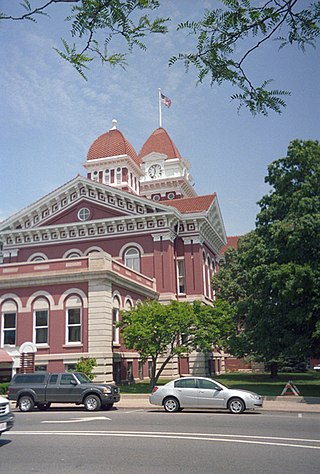
Crown Point Courthouse Square Historic District is a historic district in Crown Point, Indiana, that dates back to 1873. It was listed on the National Register of Historic Places in 2004. Its boundaries were changed in 2005, and it was increased in 2007 to include a Moderne architecture building at 208 Main Street. The late nineteenth- and early twentieth-century commercial and public buildings represent a period of economic and political growth. The Lake County Courthouse stands in the center of the district. Designed by architect John C. Cochrane in 1878, this brick building is a combination of Romanesque Revival and Classical styles. Enlarged in 1909 with the addition of north and south wings, designed by Beers and Beers. Continued growth in the county required second enlargement in 1928. This local landmark was placed in the National Register of Historic Places in 1973.

Columbus Historic District is a national historic district located at Columbus, Bartholomew County, Indiana, United States. It encompasses 574 contributing buildings and 1 contributing sites in the central business district and surrounding residential areas of Columbus. It was developed between about 1850 and 1930, and includes notable examples of Federal and Italianate style architecture. A number of commercial buildings feature locally manufactured cast iron and pressed metal components. Located in the district are the separately listed Bartholomew County Courthouse, Columbus City Hall, and First Christian Church. Other notable buildings include the First National Bank, The Crump Theatre (1889), Reo Theater, Ulrich Bakery, Samuel Harris House (1853), Keller House (1860), Old Post Office (1910), Franklin Building, Gent Mill, First United Presbyterian Church (1871-1885), Irwin Block, Irwin Home and Gardens, and St. Batholomew's Roman Catholic Church (1891).

Washington Commercial Historic District is a national historic district located at Washington, Daviess County, Indiana. The district encompasses 88 contributing buildings and 1 contributing object in the central business district of Washington. The district was developed roughly between 1815 and 1940, and includes notable examples of Italianate, Federal, and Classical Revival style architecture. Located in the district is the separately listed Daviess County Courthouse. Other notable buildings include the City Hall (1916), Temple Court (1894), Peoples National Bank (1928), Masonic Building, Indiana Theater, American Steam Laundry Building, Baltimore and Ohio Passenger Depot (1906), Westminster Presbyterian Church (1911), and U.S. Post Office (1916).
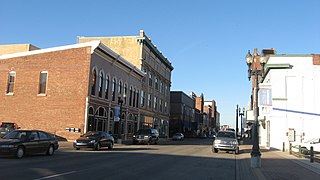
Walnut Street Historic District is a national historic district located at Muncie, Delaware County, Indiana. It encompasses 66 contributing buildings and 1 contributing object, and is located in the central business district of Muncie. The district includes notable examples of Italianate, Late Victorian, Colonial Revival, and Beaux-Arts style architecture. Located in the district are the separately listed Moore-Youse-Maxon House, Roberts Hotel, and Goddard Warehouse. Other notable buildings include the Patterson Bock, McNaughton Block (1901-1903), Mitchell Block (1909), American National Bank Building (1924), Marsh Block (1888), and the Old Post Office designed by the Office of the Supervising Architect under James Knox Taylor.

Huntingburg Commercial Historic District is a national historic district located at Huntingburg, Dubois County, Indiana. It encompasses 46 contributing buildings in the central business district of Huntingburg. They were built between about 1871 and 1956 and include notable examples of Italianate and Romanesque Revival style architecture and characterized by cast iron and stamped metal storefronts. Located in the district is the separately listed Huntingburg Town Hall and Fire Engine House. Other notable buildings include the Huntingburg Bank (1897), Huntingburg Post Office (1897), A.H. Miller Drug Store (1898), Bolte Building / First National Bank Building, Landgrebe-Kilian Building (1887), The Gem Theater (1920), The Huntingburg Bank (1926), and the American Legion (1950).
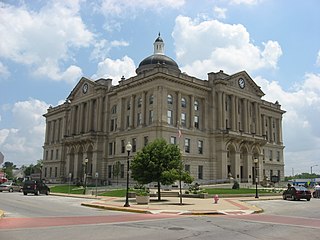
Huntington Courthouse Square Historic District is a national historic district located at Huntington, Huntington County, Indiana. The district includes 102 contributing buildings and 3 contributing structures in the central business district of Huntington. It developed between about 1845 and 1942 and includes notable examples of Italianate, Queen Anne style architecture in the United States, Romanesque Revival, Neoclassical, and Commercial style architecture. Located in the district are the separately listed Moore/Carlew Building and Hotel LaFontaine. Other notable buildings include the Hotel Huntington (1848), Opera House (1881), Lewis Block, Huntington County Courthouse (1904), old Post Office (1916), Citizens' State Bank, City Hall / Fire Station (1904), Huntington Light and Fuel Building, Our Sunday Visitor building (1926), YMCA (1929), and Huntington Theater.

Seymour Commercial Historic District is a national historic district located at Seymour, Jackson County, Indiana. It encompasses 79 contributing buildings and 4 contributing structures in the central business district of Seymour. The district developed between about 1876 and 1945, and includes notable examples of Italianate, Romanesque Revival, and Classical Revival style architecture. Located in the district is the separately listed Farmers Club. Other notable buildings include the Masonic Temple (1901), Richart Block (1900), Steinker Meat Market, Seymour National Bank, Southern Indiana Telephone and Telegraph Building (1929), Jonas Hotel, and Kidd Saloon (1887).
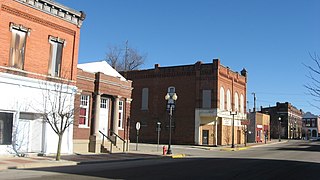
Redkey Historic District is a national historic district located at Redkey, Jay County, Indiana. It encompasses 25 contributing buildings in the central business district of Redkey. The district developed between about 1888 and 1935, and includes notable examples of Italianate, Romanesque Revival, and Classical Revival style architecture. Notable buildings include the City Building (1905), Appenseller's Department Store (1906), K of P Building (1911), Farmers and Merchants First National Bank Building, Masonic Lodge, IOOF Building, Brown-Ellis Block (1888), and Cultice-Mann Block (1891).

Edinburgh Commercial Historic District is a national historic district located at Edinburgh, Johnson County, Indiana. The district encompasses 48 contributing buildings in the central business district of Edinburgh. It developed between about 1854 and 1941, and includes notable examples of Italianate, Late Victorian and Classical Revival style architecture. Notable buildings include the Edinburgh Interurban Depot (1919), Mooney House, A. C. Thompson / Danner Building (1854), A. C. Thompson Bank (1872), Masonic Temple (1915), IOOF Building (1888), Central Hotel / Toner House (1855), and Edinburgh Town Hall (1920).
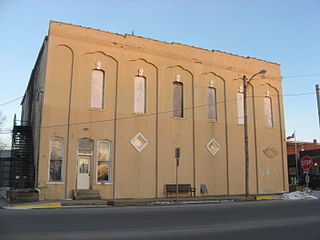
Silver Lake Historic District is a national historic district located at Silver Lake, Kosciusko County, Indiana. The district encompasses 19 contributing buildings in the central business district and surrounding residential section of Silver Lake. It developed between about 1865 and 1920, and includes notable examples of Italianate, Romanesque Revival, Classical Revival, and Early Commercial style architecture. Notable buildings include the former Enos Hotel, Municipal Building, and buildings on North Jefferson and East Main streets.

Gary City Center Historic District is a national historic district located at Gary, Indiana. The district encompasses 60 contributing buildings and 2 contributing sites in Downtown Gary. It developed between about 1906 and 1944 includes notable examples of Tudor Revival, Late Gothic Revival, and Classical Revival style architecture. Notable buildings include the City Hall and Superior Courthouse (1927), the second Gary Land Company Building, Olympic Hotel, the "Modern Apartments", Dalton Apartments, Gary State Bank Building (1929), Hotel Gary (1926), City Methodist Church (1926), YWCA Building (1922), and former U.S. Post Office Building (1936).
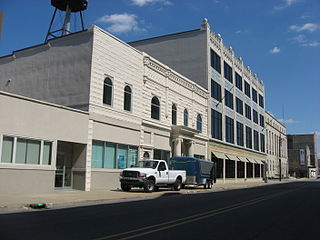
State Street Commercial Historic District is a national historic district located at Hammond, Lake County, Indiana. The district encompasses 28 contributing buildings in the central business district of Hammond. It developed between about 1885 and 1946, and includes notable example of Commercial, Classical Revival, Late Gothic Revival, and Art Deco style architecture. Notable buildings include the L. Fish Building (1927), Federal Building (1939), Lincoln Hotel (1923), Seifer Building (1925), and the Henderson Building (1902).
Hohman Avenue Commercial Historic District is a national historic district located at Hammond, Lake County, Indiana. The district encompasses 15 contributing buildings in the central business district of Hammond. It developed between about 1904 and 1956, and includes notable example of Romanesque Revival, Classical Revival, and Colonial Revival style architecture. Notable buildings include Knott's Apartments (1904), Emmerling Ambulance Garage (1918), Emmerling Building (1918), St. Joseph's Roman Catholic Church Complex, LaSalle Hotel, OK Building (1913), and the Hammond National Bank.

Franklin Street Commercial Historic District is a national historic district located at Michigan City, LaPorte County, Indiana. The district encompasses 73 contributing buildings and 1 contributing object in the central business district and surrounding residential section of Michigan City. It developed between about 1875 and 1955, and includes examples of Italianate, Gothic Revival, Queen Anne, Classical Revival, and Tudor Revival style architecture. Located in the district is the separately listed Michigan City Post Office (1909-1910). Other notable buildings include the Staiger House, Earl House, M & M Diner (1955), Zorn Building (1907), St. Paul's Lutheran Church (1876) and rectory (1888), First Federal Savings Bank, Aicher Block (1914), Brinkman Building, Trinity Episcopal Church (1889), Merchants National Bank Building (1926), Ledbetter Building (1908), Rodenbeck Saloon, First Methodist Episcopal Church (1922), Barker Hall (1929), Masonic Temple (1922-1923), and the Salvation Army Building (1925).

Downtown LaPorte Historic District is a national historic district located at LaPorte, LaPorte County, Indiana. The district encompasses 70 contributing buildings in the central business district of LaPorte. It developed between about 1860 and 1930, and includes examples of Queen Anne, Romanesque Revival, and Neoclassical style architecture. Notable buildings include the Zahrt Blocks, Ridgway Hotel (1863), Higday and Collins Blocks (1886–1888), LaPorte County Courthouse (1890–1894), Odd Fellows Building (1895), Lonn's Block (1889), People's Bank (1912), U.S. Post Office (1912), New York Central Depot (1909), Masonic Temple (1910), and Hotel Rumely (1912).

Plymouth Downtown Historic District is a national historic district located in Plymouth, Marshall County, Indiana, United States. The district encompasses 47 contributing buildings and one contributing structure in the central business district of Plymouth. It developed between about 1870 and 1940, and includes examples of Italianate, Romanesque Revival, and Colonial Revival style architecture. Located in the district is the separately listed Plymouth Fire Station. Other notable buildings include the Montgomery Ward Building (1929), Metsker Block, Rentschler Building (1910), Early Plymouth Post Office (1884), First National Bank-Plymouth City Hall, Packard Bank Block (1879), Simons Building (1895), Wheeler Block, Bank Block, Bank Block-Masonic Temple (1901), Plymouth Post Office (1935), and Plymouth Motor Sales (1929).

Paoli Historic District is a national historic district located at Paoli, Orange County, Indiana. The district encompasses 144 contributing buildings, 1 contributing site, 4 contributing structures, and 4 contributing objects in the central business district and surrounding residential sections of Paoli. It developed between about 1840 and 1940, and includes notable examples of Greek Revival, Italianate, and Queen Anne style architecture. Located in the district are the separately listed Thomas Newby Braxtan House and Orange County Courthouse. Other notable contributing resources include Lithia Springs Park, Dr. J.H. Sherrod House (1885), Gabbert House, Lithia Water Bottling Plant (1920), Orange County Jail (1858), U.S. Post Office (1937), Presbyterian Church (1920), Methodist Episcopal Church (1888), Braxtan Store, Riley Building (1887), Paoli State Bank (1912), and Thomas Volney Thornton House (1846).

Rushville Commercial Historic District is a national historic district located at Rushville, Rush County, Indiana. The district encompasses 54 contributing buildings in the central business district of Rushville. The district developed between about 1847 and 1940 and includes notable examples of Greek Revival, Italianate, Romanesque Revival, Classical Revival, Collegiate Gothic, Commercial style, and Art Deco style architecture. Located in the district are the separately listed Durbin Hotel, Melodeon Hall, and Rush County Courthouse. Other notable buildings include the former Methodist Episcopal Church (1847-1850), Church of Christ / Boys' and Girls' Club (1850-1853), Beher-King Block (1883), Presbyterian Church (1892-1893), Rushville National Bank (1911), Phoenix Lodge (1913–1915), Rushville Public Library, and former Castle Theatre (1939).

Twelve Points Historic District is a national historic district located at Terre Haute, Vigo County, Indiana. It encompasses 12 contributing buildings in a suburban commercial district of Terre Haute. It developed between about 1905 and 1954, with most built between 1890 and 1920, and includes representative examples of Commercial, Art Deco, and Classical Revival style architecture. Notable buildings include the Twelve Points State Bank (1919), People State Bank (1923), Twelve Points Hotel (1908), and Garfield Theater / Harmony Hall (1939).























